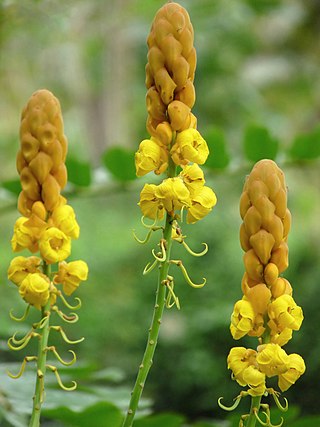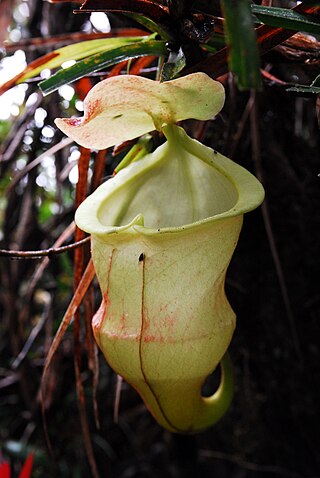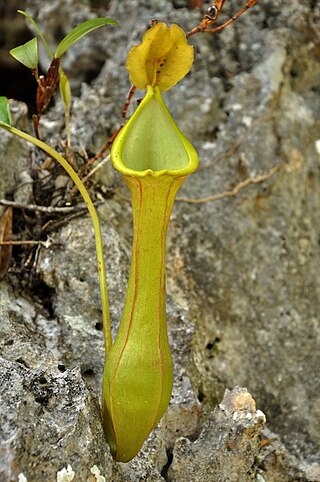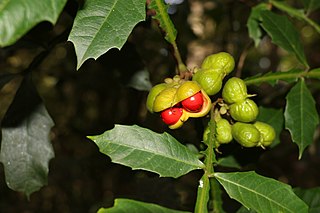
Peperomia is one of the two large genera of the family Piperaceae. It is estimated that there are at least over 1,000 species, occurring in all tropical and subtropical regions of the world. They are concentrated in South and Central America, but may also be found in southern North America, the Caribbean islands, Africa, Oceania, and southern and eastern parts of Asia. The exact number of species is difficult to determine, as some plants have been recorded several times with different names, and new species continue to be discovered. Peperomias have adapted to many different environments and their appearances vary greatly. Some are epiphytes or lithophytes, and many are xerophytes or possess underground tubers (geophytes). Most species are compact perennial shrubs or vines.

The Piperaceae, also known as the pepper family, are a large family of flowering plants. The group contains roughly 3,600 currently accepted species in five genera. The vast majority of species can be found within the two main genera: Piper and Peperomia.

Nepenthes benstonei is a tropical pitcher plant endemic to Peninsular Malaysia, where it grows at elevations of 150–1350 m above sea level. The specific epithet benstonei honours botanist Benjamin Clemens Stone, who was one of the first to collect the species.

Ulmus alata, the winged elm or wahoo, is a small- to medium-sized deciduous tree endemic to the woodlands of the southeastern and south-central United States. The species is tolerant of a wide range of soils, and of ponding, but is the least shade-tolerant of the North American elms. Its growth rate is often very slow, the trunk increasing in diameter by less than 5 mm per year. The tree is occasionally considered a nuisance as it readily invades old fields, forest clearings, and rangelands, proving particularly difficult to eradicate with herbicides.

Senna alata is an important medicinal tree, as well as an ornamental flowering plant in the subfamily Caesalpinioideae. It also known as emperor's candlesticks, candle bush, candelabra bush, Christmas candles, empress candle plant, ringworm shrub, or candletree. A remarkable species of Senna, it was sometimes separated in its own genus, Herpetica.

Peperomia graveolens, commonly known as Ruby Glow, is a species of plant in the genus Peperomia of the family Piperaceae. It is endemic to Ecuador.
Peperomia thomeana is a species of plant in the family Piperaceae. It is found in Cameroon, Equatorial Guinea, and São Tomé and Príncipe. Its natural habitat is subtropical or tropical dry forests. It is threatened by habitat loss.

Peperomia pellucida is an annual, shallow-rooted herb, usually growing to a height of about 15 to 45 cm, it is characterized by succulent stems, shiny, heart-shaped, fleshy leaves and tiny, dot-like seeds attached to several fruiting spikes. It has a mustard-like odor when crushed.

Enceliopsis covillei, known by the common name Panamint daisy, is a rare North American desert species of flowering plant in the family Asteraceae.

Nepenthes hamiguitanensis is a tropical pitcher plant endemic to a single peak on the Philippine island of Mindanao, where it grows at elevations of 1200–1600 m above sea level. Once thought to be a natural hybrid between N. micramphora and N. peltata, this plant is now considered a species of possible hybridogenic origin. It produces squat upper pitchers that vary greatly in pigmentation, from red speckled to yellow throughout.

Peperomia obtusifolia, also known as the baby rubberplant, American rubber plant, or pepper face, is a species of flowering plant in the genus Peperomia under the family Piperaceae, native to Tropical America. The specific epithet obtusifolia means "blunt-leaved". The plant has gained the Royal Horticultural Society's Award of Garden Merit.

Nepenthes viridis is a tropical pitcher plant endemic to the Philippines. It is known only from coastal areas at low altitude and has been recorded from Dinagat, Samar, and a number of surrounding islets. It is closely allied to the N. alata group of species.

Harpullia alata, commonly known as winged tulip or wing-leaved tulip, is a species of flowering plant in the family Sapindaceae, and is endemic to eastern Australia. It is a tree with paripinnate leaves, the leaflets elliptic with teeth on the edges, white flowers and capsules containing a seed with a yellow to reddish aril.

Dampiera alata is a plant in the family Goodeniaceae, native to Western Australia.

Peperomia maculosa, commonly known as spotted-stalked peperomia and spotted peperomia, is a species of plant in the genus Peperomia. Its native range is from Mexico to northern South America.

Peperomia quadrangularis, commonly known as the beetle peperomia, is a species of plant in the genus Peperomia of the family Piperaceae. Its native range is in tropical America, including areas in northern South America, Central America and the West Indies.
Peperomia kimnachii is a species of plant in the genus Peperomia of the family Piperaceae. It is native to Bolivia, often growing as an epiphyte.

Peperomia ursina is a species of epiphyte or lithophyte from the genus Peperomia. It was first described by Michael Howard Grayum and published in the book "Phytologia 79(2): 112–113. 1995[1996]". It primarily grows on wet tropical biomes.

Peperomia bellendenkerensis is a plant in the pepper family Piperaceae found only in the Wet Tropics bioregion of Queensland, Australia.

Peperomia hunteriana is a plant in the pepper family Piperaceae found only in the Wet Tropics bioregion of Queensland, Australia.


















